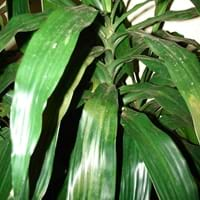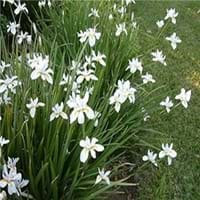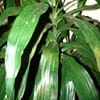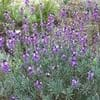Life Span
Annual
Perennial
Type
Tender Perennial
Tender Perennial
Origin
Africa
Southern Asia
Types
Not Available
African iris, Large wild iris, Cape iris
Number of Varieties
Not Available
Habitat
tropical environments, Well Drained
Coastal Regions, Forest margins, Slopes
USDA Hardiness Zone
10-15
9-11
Sunset Zone
H2, 21, 23, 24
H1, H2, 8, 9, 12, 13, 14, 15, 16, 17, 18, 19, 20, 21, 22, 23, 24
Habit
Upright/Erect
Clump-Forming
Flower Color
White
White, Yellow, Blue, Violet
Flower Color Modifier
Bicolor
Bicolor
Fruit Color
Orange
Green, Brown
Leaf Color in Spring
Dark Green
Green, Gray Green
Leaf Color in Summer
Dark Green
Green, Gray Green
Leaf Color in Fall
Dark Green
Green, Gray Green
Leaf Color in Winter
Light Green
Light Green
Leaf Shape
Linear
Grass like
Plant Season
Spring, Summer, Fall, Winter
Spring, Summer, Fall, Winter
Sunlight
Full Sun, Partial Sun, Partial shade
Full Sun, Partial Sun, Partial shade
Growth Rate
Medium
Medium
Type of Soil
Loam, Sand
Clay, Loam, Sand
The pH of Soil
Acidic, Neutral
Acidic, Neutral, Alkaline
Soil Drainage
Well drained
Average
Bloom Time
Late Summer, Early Fall, Fall, Late Fall
Indeterminate
Tolerances
Drought
Drought
Where to Plant?
Container, Ground, Pot
Ground
How to Plant?
Rooted stem cutting, Stem Cutting
Seedlings, Stem Cutting, Stem Planting
Plant Maintenance
Medium
Medium
Watering Requirements
Do Not over Water, Water Deeply, Water in morning to avoid prompting diseases, Water in the early morning hours
Average Water Needs, Water more in summer
In Summer
Lots of watering
Lots of watering
In Spring
Moderate
Moderate
In Winter
Average Water
Average Water
Soil pH
Acidic, Neutral
Acidic, Neutral, Alkaline
Soil Type
Loam, Sand
Clay, Loam, Sand
Soil Drainage Capacity
Well drained
Average
Sun Exposure
Full Sun, Partial Sun, Partial shade
Full Sun, Partial Sun, Partial shade
Pruning
Cut or pinch the stems, Remove damaged leaves, Remove dead branches, Remove dead leaves, Remove deadheads
Cut or pinch the stems, Remove damaged leaves, Remove dead branches, Remove dead leaves, Remove dead or diseased plant parts, Remove deadheads, Remove short twigs, Remove wet foliage
Fertilizers
All-Purpose Liquid Fertilizer, Apply N-P-K, fertilize in growing season
Apply N-P-K
Pests and Diseases
Insects, Leaf spot, Mealybugs, Mites, Red blotch, Root rot
Red blotch
Plant Tolerance
Drought, Humidity, Shade areas
Drought
Flowers
Insignificant
Yes
Flower Petal Number
Single
Single
Foliage Texture
Coarse
Medium
Foliage Sheen
Glossy
Matte
Attracts
Mealybugs, Mites
Bees, Butterflies, Flying insects, Insects
Allergy
Not Available
Not Available
Aesthetic Uses
Beautification, Showy Purposes
Borders, Ground Cover, Showy Purposes, Water gardening
Beauty Benefits
Not Available
Not Available
Edible Uses
No
Insignificant
Environmental Uses
Air purification
Air purification, soil stabilisation, Windbreak
Medicinal Uses
Not Available
Not Available
Part of Plant Used
Not Available
Flowers
Other Uses
Not Available
Screen, useful as a ground cover
Used As Indoor Plant
Yes
No
Used As Outdoor Plant
Yes
Yes
Garden Design
Container, Feature Plant, Foundation, Houseplant, Tropical
Bedding Plant, Bog Garden, Container, Groundcover, Mixed Border, Tropical, Water Gardens
Botanical Name
DRACAENA fragrans 'Janet Craig'
DIETES grandiflora
Common Name
Corn Plant, Janet Craig Dracaena
Butterfly Iris
In Hindi
Janet Craig Dracaena
तितली आइरिस प्लांट
In German
Janet Craig Dracaena
Schmetterling Iris Pflanzen
In French
Janet Craig Dracaena
Papillon Iris Plante
In Spanish
Janet Craig Dracaena
Planta del iris de la mariposa
In Greek
Janet Craig Dracaena
Πεταλούδα Iris Φυτών
In Portuguese
Janet Craig Dracaena
Borboleta da planta Iris
In Polish
Janet Craig Dracena
Butterfly Iris Roślin
In Latin
Johann Peter Dracaena
Gloria Iris Planta
Phylum
Tracheophyta
Magnoliophyta
Class
Magnoliopsida
Liliopsida
Order
Asparagales
Liliales
Family
Agavaceae
Iridaceae
Genus
Dracaena
Dietes Salisb
Clade
Angiosperms, Monocots
Angiosperms, Monocots
Tribe
Not Available
Irideae
Subfamily
Not Available
Iridoideae
Number of Species
Not Available
Not Available
Season and Care of Janet Craig Dracaena and Butterfly Iris
Season and care of Janet Craig Dracaena and Butterfly Iris is important to know. While considering everything about Janet Craig Dracaena and Butterfly Iris Care, growing season is an essential factor. Janet Craig Dracaena season is Spring, Summer, Fall and Winter and Butterfly Iris season is Spring, Summer, Fall and Winter. The type of soil for Janet Craig Dracaena is Loam, Sand and for Butterfly Iris is Clay, Loam, Sand while the PH of soil for Janet Craig Dracaena is Acidic, Neutral and for Butterfly Iris is Acidic, Neutral, Alkaline.
Janet Craig Dracaena and Butterfly Iris Physical Information
Janet Craig Dracaena and Butterfly Iris physical information is very important for comparison. Janet Craig Dracaena height is 180.00 cm and width 90.00 cm whereas Butterfly Iris height is 70.00 cm and width 50.00 cm. The color specification of Janet Craig Dracaena and Butterfly Iris are as follows:
Janet Craig Dracaena flower color: White
Janet Craig Dracaena leaf color: Dark Green
Butterfly Iris flower color: White, Yellow, Blue and Violet
- Butterfly Iris leaf color: Green and Gray Green
Care of Janet Craig Dracaena and Butterfly Iris
Care of Janet Craig Dracaena and Butterfly Iris include pruning, fertilizers, watering etc. Janet Craig Dracaena pruning is done Cut or pinch the stems, Remove damaged leaves, Remove dead branches, Remove dead leaves and Remove deadheads and Butterfly Iris pruning is done Cut or pinch the stems, Remove damaged leaves, Remove dead branches, Remove dead leaves, Remove dead or diseased plant parts, Remove deadheads, Remove short twigs and Remove wet foliage. In summer Janet Craig Dracaena needs Lots of watering and in winter, it needs Average Water. Whereas, in summer Butterfly Iris needs Lots of watering and in winter, it needs Average Water.





